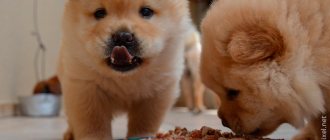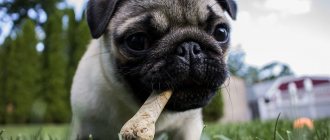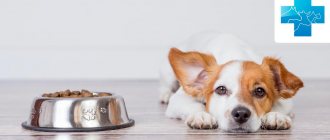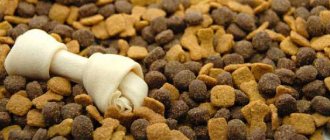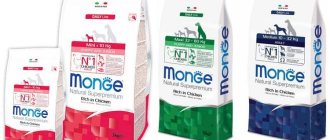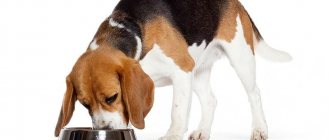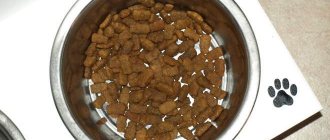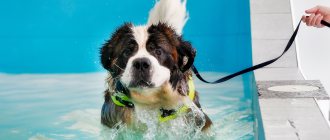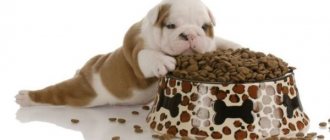First you need to decide whether you can feed your pet natural food or whether you will use ready-made food.
We feed ours exclusively natural food, so I’ll tell you more about this.
First, a diet for puppies. Dalmatians are usually purchased when they are one and a half months old. Consequently, they have already been weaned off mother's milk. What can you give them? Low-fat cottage cheese, lean minced meat, oatmeal cooked from crushed cereal, and pureed vegetables. In small quantities, it is allowed to give raw liver, which is full of microelements necessary for growth. After 2 months, the Dalmatian should be given fish - pollock or cod, preferably cooked in the form of meatballs. Small puppies are fed 6 times a day, and by the age of one year the number of feedings is gradually reduced to 2-3. There is no need to strictly adhere to two meals a day. This is what people who have to go to work do. If you are not working, feed your dog three times a day.
About the diet for an adult dog. From 30 to 50% of the food should be meat, namely horse meat, beef, rabbit and lamb. The dog should receive 20 g of meat per 1 kg of its weight per day. Next, 25-35% - porridges from various cereals. You can give buckwheat, rice, barley and oatmeal. Occasionally - peas. Add vegetables and meat to the porridge at the end of cooking. 20-30% dairy products - kefir, cottage cheese, yogurt, yogurt. Fresh milk should not be fed. 15-20% – vegetables. Everything the dog ate as a child, plus white cabbage. It is worth adding boneless fish to your food. But sea food must be raw and frozen, and river food must be boiled or frozen. And also fruits. Any kind the dog likes. This will be her treat.
In the case of ready-made food, everything is simple - the higher its class, the better for the pet.
Why does Dalmatian require special feeding?
When studying the breed, an unexpected fact was established that the Dalmatian's body (like humans) produces excess uric acid when receiving a large amount of protein. Moreover, the process starts only when there is a glut of plant proteins, that is, proteins contained in cereals and vegetables. This does not mean that Dalmatians can be fed only with products of animal origin; cereals are needed, but their selection includes several conditions:
- Absolutely not - semolina, corn grits.
- Not recommended - millet, pearl barley and wheat groats, oat flakes (gives a yellowish coat).
- You can use barley, buckwheat and rice groats, the last two are preferable.
Note! Pearl barley is introduced into a dog’s diet if they have weight problems. In the case of Dalmatians, you should consult your veterinarian before changing his diet.
Almost all short-haired dogs are prone to dermatitis due to an allergic reaction to food. For dogs at risk, the same products as for people: chicken eggs, bee products, semi-finished products, industrial dairy products, soy, sausages, meat and fish processed with liquid smoke. Dietary food is selected for dogs with allergies. When an allergen is identified, it is excluded. It happens that the cause of allegri cannot be identified, and then the owner has only one choice - to choose hypoallergenic dry food for the Dalmatian, in accordance with his age and weight.
Important! Dalmatians are choleric by nature; dogs usually absorb food very quickly, and the owner may doubt whether the portion is of sufficient size? The daily food intake is calculated based on the dog’s needs, and intuitive “supplements” lead to obesity and health problems.
Natural diet or “drying”?
Most cynology reference books make a slight hint that “natural” food is still healthier and more natural than industrial food. In reality, everything is not so simple. High-quality food contains a perfectly balanced amount of vitamins and nutrients for dogs of a specific build. Also, food is produced for animals with different types of hair.
A natural diet is considered more natural and this is true, but with manual dosing there is always an error. A small miscalculation may not affect the health of the animal if it is noticed in time. There is also “the other side of the coin”, for example, a lack of calcium or an excess of proteins can be detected late, when irreversible consequences have already occurred.
The main issue is the quality of the products. Stale products are much more harmful than food; poor-quality drying is a targeted course to enrich veterinary clinics. Food for Dalmatians is selected individually, but its class should not be lower than “Premium”; the preferred series is “For active pets”.
Important! An iron rule - if you feed your dog dry food, clean water should always be in a bowl and in easy access.
Which owner is it suitable for?
Due to the strong will that Dalmatians have, they can be stubborn or disobedient if in the wrong hands. The ideal Dalmatian owner should be energetic, confident and persistent. It’s good if such a dog is adopted by a person who already has experience in training pets and can direct all the dog’s energy and perseverance in the right direction. You should not buy Dalmatians for older people, those who are inactive or too busy, since dogs require regular physical activity and long walks in the fresh air.
Basics of proper dog nutrition
With dry food everything is quite simple and the main points are described above. Two more advantages are not indicated - saving the owner’s time and the ability to use an automatic feeder. It is worth clarifying a few more nuances about the natural diet:
- The ideal ready-made food is well-cooked porridge, diced meat and grated vegetables. Proportion 33:33:33%. The remaining 1% involves vitamins or other supplements.
- An adult dog eats 1 or 2 times per meal. The daily food intake is divided into the number of meals.
- You need to feed your Dalmatian puppy not only often, but also plentifully. The share of meat and offal is increased to 50%; calcium, feed yeast and vitamin supplements are fed daily.
- Given the tendency to allergies, dairy products are fed with extreme caution and are excluded from the diet of an adult dog (if necessary).
- Before feeding the meat, it must be cut into cubes and doused with boiling water.
- Dried seaweed is very beneficial and is often recommended by veterinarians, but such supplements can affect the color of the coat.
- To improve coat quality and digestion, Dalmatians are given live yogurt, natural kefir or probiotic supplements.
- According to generally accepted rules, the daily calorie intake is calculated based on the age of the puppy or the weight of the adult dog. For an adult Dalmatian, the norm is 69 kcal/kg.
Note! No matter how ideal the diet, the dog’s weight must be constantly monitored. Depending on the season of the year, the diet is adjusted based on the dynamics of weight gain/loss.
Source
Buy a Dalmatian: tips and tricks
When purchasing a puppy of this breed, it is a good idea to familiarize yourself with its pedigree, assessing the exterior accordingly and paying attention to the puppy’s behavior. If the puppy is cheerful, has an excellent appetite, is quite active and inquisitive, and is at the same time a little plump, then this indicates his health. When a puppy develops correctly, it should not have pronounced ribs or a retracted abdomen.
Where to buy and what to look for
It is better to buy a puppy that has reached one and a half or two months of age. When purchasing, first of all you should pay attention to:
- For the color of the nose: it should be black or brown.
- On the tail, which should not be curled into a ring or thrown over the back.
- For a bite that should not be too tight.
Important point! It is very important that the puppy has excellent hearing. Testing your hearing is very simple, just clap your hands loudly. The dog should react to this clap instantly.
Universal testing should also not be abandoned. To do this, you need to take a tennis ball, a metal bowl or mug, a rug or a small piece of artificial wool, and then:
- Objects are brought closer to the puppy to evaluate his reaction. The correct response should be accompanied by a jubilant bark and a wagging tail. Showing indifference or fear is undesirable.
- The puppy's attention is attracted with the help of a rug or piece of artificial wool. They are dragged jerkily across the floor, and the puppy should show interest in such a moving object with a desire to chase it.
- The puppy is drawn into the game by an object thrown behind him. The puppy may be frightened for a short time, but after coping with the fright, it sniffs the object and returns to its original place.
The final stage of testing involves testing the puppy for its ability to chase objects or fetch a thrown tennis ball.
One should not ignore the fact that a purebred Dalmatian can most likely or be guaranteed to be purchased only in specialized nurseries that practice breeding dogs of this breed. In addition, the puppy receives all the necessary accompanying documents, proper care and qualified veterinary care.
Dalmatian dog price
The cost of puppies depends on many factors. Basically, the price is determined depending on the purebred, which can be certified by KCY-FCI documents. In addition, the puppy must have a veterinary passport, which indicates all vaccinations, as well as the deworming process. If the puppy fully complies with breed standards, then its cost will be:
- In the city of Moscow - from 30 to 60 thousand rubles.
- In the city of St. Petersburg - from 20 to 45 thousand rubles.
- In Rostov-on-Don - from 15 to 30 thousand rubles.
- In Ukraine – from 12 to 30 thousand rubles.
If puppies have some breed defects, then they are much cheaper, and such puppies are not used in breeding work or in exhibition shows. This does not mean at all that such a Dalmatian will not become a companion dog, and for relatively little money.
Dalmatian food
First you need to decide whether you can feed your pet natural food or whether you will use ready-made food.
We feed ours exclusively natural food, so I’ll tell you more about this.
First, a diet for puppies. Dalmatians are usually purchased when they are one and a half months old. Consequently, they have already been weaned off mother's milk. What can you give them? Low-fat cottage cheese, lean minced meat, oatmeal cooked from crushed cereal, and pureed vegetables. In small quantities, it is allowed to give raw liver, which is full of microelements necessary for growth. After 2 months, the Dalmatian should be given fish - pollock or cod, preferably cooked in the form of meatballs. Small puppies are fed 6 times a day, and by the age of one year the number of feedings is gradually reduced to 2-3. There is no need to strictly adhere to two meals a day. This is what people who have to go to work do. If you are not working, feed your dog three times a day.
Origin of the breed and purpose
Today people do not know all the facts about the origin of the Dalmatians, all its pros and cons, its history. But, as numerous studies and excavations show, the Dalmatian breed is one of the most ancient. This is determined primarily by the skulls that were found during excavations. The remains of the Ash Dog, found in the territories of Austria and Bohemia, date back to the end of the Bronze Age of human history. It is believed that they are the ancestors of modern spaniels, braques, bloodhounds, etc. However, the skull of a modern Dalmatian is most similar to that of an ashy dog.
Hound dogs also include breeds such as the Basset Hound, Beagle and Estonian Hound.
The first figurines of spotted dogs were found in Mediterranean countries and date back to 4000-2000 BC. e. Rock carvings of such dogs date back to the times of ancient Egyptian civilization. As for the homeland of the Dalmatians, it is considered to be Dalmatia, a historical province of Yugoslavia. In their historical homeland, such dogs are now rare, while, for example, in England they are very popular. There are several assumptions about where the breed got its name. Some believe that the dogs got their name from Dalmatia, where ceramics with spotted dogs depicted on them were found.
The next theory says that the name of this breed comes from the name of the young Serbian poet Yuri Dalmatin, who received several of these dogs as a gift from a Bohemian countess, began breeding and distributing them, which he mentioned in a letter to the same countess.
And the last hypothesis regarding the origin of the name of this breed connects it with the church, allegedly the name “Dalmatian” comes from the name of the clothing of the clergy - “Dalmatics”. In ancient times, dogs of this breed were used for guarding, fighting and warning of approaching enemies. As a rule, such pets were kept in rich families. This is evidenced by numerous paintings depicting them; in 1540, one of them even appeared on the coat of arms of a noble family in England.
Feeding Dalmatians with natural food
Dalmatians should be given raw meat, scalded with boiling water. It is cut into pieces. Best absorbed:
For cereals, it is better to give this breed buckwheat or rice, cooked in water rather than in meat broth. They will also benefit from raw or boiled vegetables with sunflower oil, sea fish, cottage cheese and other fermented milk products, sometimes boiled eggs and cheese.
You will also need special vitamins and mineral supplements. However, many Dalmatians are very picky or do not respond well to natural food. Therefore, it is easier to use dry food for them.
Feeding your Dalmatian dry food
Since Dalmatians are often prone to allergic reactions to low-quality food products, as well as food additives and dyes. Therefore, it is better not to give them cheap, untested food. Breeders prefer dry food of at least premium, as well as super-premium class from such well-known manufacturers as:
They contain high quality foods, including real meat, and minimal grains, purines, soy and preservatives. At the same time, veterinarians do not advise choosing food from the series “for active dogs.” Yes, the Dalmatian is a very energetic dog, but this food always contains a high amount of protein, which is unacceptable for this dog’s body.
The most suitable foods for Dalmatians are super-premium foods such as Jams, Eukanuba, Hill`s. From these you need to choose a line of food for medium breed dogs. You can add kefir or sunflower oil to your Dalmatians' food, which significantly improves their coat. Sometimes you can give vegetable salads with apples, sweet peppers, and carrots.
Did you like it? Share with your friends!
Give it a like! Write comments!
Story
The age of the rock is several thousand years. Cynologists have not come to a consensus about which country is the homeland of Dalmatians. One version says that Dalmatians appeared in India. Then the dogs came to Italy, and a little later they were brought to Dalmatia (one of the regions of Croatia).
Dalmatians accompanied carriages with noble people. The dogs walked ahead of the horses and protected the carriage passengers from attacks by robbers and predatory animals. England is considered the second homeland of Dalmatians. It was in this country that the first description of the breed appeared in 1890. The international breed standard was approved in 1926 in Monaco.
What to feed your Dalmatian
An adult Dalmatian can be fed many foods, the main thing is not to feed those on the prohibited list. Below we give an example of a diet for an adult dog that is also suitable for a Dalmatian.
Diet for a Dalmatian
- 30-50% meat. Dalmatians can eat lamb, lean beef, rabbit, and horse meat. It is not recommended to give minced meat to an adult dog. By-products (liver, heart, etc.) can also be given. Ideally, a Dalmatian needs 20 grams of meat per kilogram of weight (per day).
- 25-35% coarse. You can have buckwheat, rice. barley, oatmeal, sometimes peas (but in small quantities). The cereal is prepared like regular porridge; you can add boiled vegetables or meat to it (added at the end of cooking).
- 20-30% dairy products. You can have cottage cheese, kefir, yogurt, yogurt. It is not recommended to give fresh milk to an adult Dalmatian.
- 15-20% vegetables. Carrots, pumpkin, cucumbers, beets, zucchini, bell peppers, white cabbage - all this is well absorbed by the dog’s body. Vegetables are a source of many vitamins.
- Fish. From time to time, instead of meat, your Dalmatian can be given fish. At the same time, sea fish can be given raw (or preferably frozen), and river fish must be boiled or frozen. The bones should be pulled out.
- Fruits. Many Dalmatians love various fruits, and you can give them to your pet as treats.
Dogs should not be given sweets at all. Photo by Leo Hidalgo.
What is it sick with?
The most sensitive areas and organs of Dalmatians include the kidneys and skin. They often develop urolithiasis. The first symptoms are pain in the lumbar region; the dog experiences difficulty when he wants to lie down or stand up, or when jumping. Kidney problems are reflected in the skin, which becomes bronze. In this case, abscesses, bald patches, and allergic reactions appear on it. In 12% of cases, dogs of this breed are born deaf. Dalmatians may suffer from:
- hip dysplasia;
- gastric volvulus;
- glaucoma and progressive retinal atrophy.
Features of Dalmatian keeping
The Dalmatian is a strong and fairly large animal with excessive energy. This friendly and courageous pet, endowed with enormous willpower, is most suitable for a person who has certain skills in training such animals.
Dalmatians love children. Dogs have a cheerful and vindictive character at the same time; familiarity with them should not be allowed. Although they often show their temper, they still obey an attentive and intelligent owner. A strong feature of this breed is the desire to accompany the owner everywhere. The Dalmatian is an active and sociable dog that can serve as a guard dog. A minor drawback is that the dog remembers its offenders.
If he is kept tied up on a chain, he can become aggressive, uncontrollable and embittered. This short-haired breed is not suited to living outside all year round - it is cold there in winter. Warm overalls are required for winter walks. For normal functioning, such dogs require movement, walks and physical activity.
Caring for a Dalmatian is not difficult.
To remove dead hair, it is advisable to comb it daily. This breed is distinguished by its cleanliness. Therefore, there is no need to bathe him often; once a year is enough. There is almost no smell coming from them.
It is imperative to trim the nails, because very long ones do not allow the paws to shrink. It is necessary to regularly inspect drooping ears, which need to be cleaned of accumulated dirt and wax using a cotton swab dipped in an antiseptic solution or water.
Dalmatian: owner reviews
“We adopted an 8-month-old Dalmatian and were his fourth owners. The previous ones abandoned the boy for various reasons. At the last owner's, Richie threw back and broke a hefty plasma, chewed up cosmetics and a passport left on the table. We're stunned, we had to put in a lot of work for him to master the rules of behavior in society. At one year old, they decided to castrate him, since he could easily rush after a female in heat without looking back at the owners. The habit of chewing furniture and everything around remains the same, we try not to leave it alone for a long time.”
“Messy lived in our family for 13 years, and I can’t imagine a better dog than a Dalmatian. The only thing that bothered me was the irrepressible delight of all passers-by, especially children (oh, what a dog, can I pet it?). An intelligent dog with an expressive muzzle and a club tail, he ran around and played like a puppy until his old age. I strongly disagree that Dalmatians are stupid. Not at all! They just don’t follow commands thoughtlessly, maybe that’s what people mean.”
“Monica woke me up in the morning, poking my cold nose into my heels, and during meals she portrayed such universal sorrow that no, no, you’ll even treat me to a piece of cheese. Previously, I only dealt with shepherd dogs, and after them the Dalmatian is perceived not as a dog, but as a person. Moreover, a person with a fine mental organization. This is definitely not a dog for training, but rather a beautiful companion. I regret that I didn’t breed my princess. The pain of the loss does not subside."
“Guy howled alone. Fortunately, a year later we moved from an apartment to a private house, and our dog simply blossomed. From somewhere, protective qualities appeared, the handsome spotted guy became mature and pumped up his muscles, running in the forest. I see a huge advantage in the fact that neither adults nor children are afraid of such a dog, I can calmly walk with him without a leash.”
“Mike was my first dog, and my nightmare. My dog could not get used to relieving himself on the street, and when he grew up, he began to pick up all sorts of nasty things on the street, like a vacuum cleaner. Due to the constant shedding, the entire sofa was covered in wool, and it was time to throw away all the black clothes - they, too, became covered in white hairs. Chewed shoes, wallpaper and linoleum. He threw himself at small dogs; if he didn’t stop them, he could probably bite them to death. I couldn’t cope with my upbringing, I just couldn’t imagine what a Dalmatian was. He died tragically from a foreign body in the intestines; the operation was too late.”
“Smart, loyal, endlessly affectionate dog. My wife was jealous of Julia, but I doted on her. She loved to be photographed, as if she was posing on purpose. For me, the Dalmatian remains the standard of canine beauty."
What is it sick with?
The most sensitive areas and organs of Dalmatians include the kidneys and skin. They often develop urolithiasis. The first symptoms are pain in the lumbar region; the dog experiences difficulty when he wants to lie down or stand up, or when jumping. Kidney problems are reflected in the skin, which becomes bronze. In this case, abscesses, bald patches, and allergic reactions appear on it. In 12% of cases, dogs of this breed are born deaf. Dalmatians may suffer from:
- hip dysplasia;
- gastric volvulus;
- glaucoma and progressive retinal atrophy.
Dalmatian birth
How long the birth will last is influenced by the number of puppies and the intervals between their births, generally it ranges from 10 minutes to half an hour .
By the time labor is completed, the pause between appearances increases to 1.5–2 hours. The kitten is born in a bubble, feet first or head first, back up. As a rule, the placenta comes out with the puppy or during the next contraction.
The bitch needs the owner's help if the puppy has difficulty getting out. When part of it has already appeared, you need to take it with a napkin and carefully pull it out.
Puppies
At 2–2.5 months, Dalmatian puppies become independent and independent of their mother. At this time, their character is already visible. A kitten that bullies other puppies will turn into a self-confident dog. An owner with a strong character will be able to raise him correctly. Sloths and food lovers will be the same for adults.
The skin seems too big for a Dalmatian puppy because it bunches up. In healthy kittens, the fur is smooth, shiny and has no bald spots. The breed is distinguished by:
- flat back;
- high-set and tightly pressed ears;
- saber-shaped tail, not rising high from the back.
Babies have dark blue eyes, which turn brown after 2 months. Having blue eyes is considered a defect. Little Dalmatians need to buy toys for them to carry and chew on. It is best if they are made from natural materials. Size also matters; don't give them ones that they could swallow or choke on .
How many puppies are born?
The day of mating affects the fertility of dogs. To get a lot of fruits, you need to knit with the maximum number of ripe eggs. Their quantity and quality are ensured by:
- health of the bitch;
- diet;
- hormonal levels;
- conditions of detention.
If an animal is overfed or, on the contrary, exhausted, then it will not bear offspring at all, or there will be few puppies. The number of cubs is directly influenced by the male dog, namely:
- age;
- breeding frequency;
- feeding ration.
If a male dog is more than 10 years old or if he is bred more than 2 times a month, there are very few sperm. And those weak ones, not all of them cope with their task.
What do newborn kittens look like?
Pigment spots begin to appear by the second week. The purity of the blood is indicated by their location and intensity. The body has no signs of asymmetry, the spots are clear.
Description by month
The weight of a newborn Dalmatian ranges from 350 to 450 grams. In 1 month it becomes 10 times heavier. Due to their active nature, babies eat 3 times more food than adult dogs. It is imperative to ensure that there is no overeating. At 2 months their weight should reach 7–9 kg.
Performance evaluation and information
The Dalmatian dog has a characteristic coloring: black or brown spots of different sizes on a white background throughout the body.
- Height: for a male - up to 61 cm, for a female - about 57 cm.
- Weight: males - 15-32 kg, females - 16-24 kg.
- Country of origin: Yugoslavia.
- Life expectancy: about 12 years.
Did you know? Animal rights first began to be protected in Japan in the 17th and 18th centuries, when a law was passed that stated that killing dogs was punishable by execution, and townspeople had to address dogs on the street as “High Nobility Dog.”
What to feed?
For normal growth, Dalmatians must eat properly. You need to choose natural, balanced food or special premium food for puppies. A balanced diet is a comprehensive menu consisting exclusively of healthy foods. If you give your puppy both at once, he will get an upset stomach.
The diet must include:
- boiled fish fillet and tender meat;
- fruits and vegetables;
- porridge;
- 2 eggs per week;
- cottage cheese;
- greenery.
Raising a dog
It is important to begin education from the first days of life so that the kitten understands that the boss in the house is the owner. Otherwise the dog will grow up uncontrollable. She needs to explain what is not allowed:
- bite;
- climb into bed;
- chew shoes;
- beg for food from the table.
In upbringing, the owner must be persistent, patient and confident. Dalmatians are emotional and extremely sensitive dogs, so you should not be rude to them. It is forbidden to hit the puppy, shout at him for his offense and disobedience, you can pat him by the withers or simply scold him. Punish only if he is directly caught on the spot.
Dalmatians easily master commands such as “No!”, “Come to me!”, “Place!”. However, he quickly gets bored with monotonous activities, so after a short period of time you need to start teaching him more complex commands.
Character of Dalmatians
A description of the Dalmatian breed will be incomplete without considering all the advantages and disadvantages of the character of such dogs. Dalmatians are companion dogs, family dogs. They are distinguished by their activity and confidence, energy and ingenuity. Such dogs are courageous and friendly, which makes them good protectors and true devoted friends of their owners. As a rule, such pets do not show any angry reaction to strangers. They can behave friendly with them or just standoffishly.
However, attitude towards strangers is a very individual thing and it all depends on the specific dog and the specific person. As for describing the attitude of representatives of this breed towards children, it is worth saying that Dalmatians easily get along with them, especially if they grow up together. They can even act as babysitters for children, keeping an eye on them and telling parents when a child is in danger. These dogs don't have many disadvantages. They can cause problems for their owners and cause mischief if they lack attention or physical activity, if they have nowhere to put their energy.
Nicknames for Dalmatians
Some representatives of this unique dog breed exhibit noticeable personality traits combined with high mental abilities. Such rare nicknames as Vanilla, Friendship, Ibiza, Blizzard, Prelest, Zhador, Fifa, Rocket, Cinzano are suitable for these Dalmatians.
The unique eye-catching coloration of Dalmatians in the form of bright black spots on a snow-white background creates clever combinations. Thanks to this unique feature, the following nicknames are appropriate: Aesthete, Handsome, White, Harlequin, Pattern, Jade, Jacquard, Star.
Previously, this breed of dogs was specially bred to accompany carriages and run in front of them, thereby clearing the road.
Animals of this breed have such qualities as incredible mobility and energy. Therefore, the nicknames are perfect for them: Rebel, Vanguard, Wind, Vassal, Jacques, Zero, Kois, Alarm, Olympus, Prince, Ron, Faust, Tito, Eden, Yarvi.
Dalmatian girls are distinguished by their cheerfulness and mobility. They must communicate with humans. They can be given nicknames such as: Adele, Bertha, Gladys, Greta, Kaira, Leia, Olympia, Tiffany, Uslada, Juno.
Prices for puppies
Prices for Dalmatian puppies are individual. They are influenced by:
- parental merits;
- expenses for veterinary care;
- costs of keeping the animal.
If his parents are champions, then the cost of the party is very high. However, Dalmatians with excellent pedigree are mainly purchased for breeding or exhibition. A person who wants to buy a dog should know that the price for excellent puppies cannot be low.
A low cost may indicate a low-quality pet. By purchasing a Dalmatian for himself, a person buys himself at the same time an active, reliable, cheerful friend and a guard dog. This animal is a real hunter who will not let its owner get bored.
Source
Interesting Facts
- Dalmatians served in the English fire brigade. They ran in front of the horse-drawn carriage and barked loudly, scaring passers-by. Dalmatians actually served as special signals that are installed on modern fire trucks.
- The dark spots on the Dalmatian's body range in size from 3 to 6 centimeters.
- Dogs love to lick their owner's face. Thus, they express their joy and gratitude.
- One litter can have Dalmatians with three different colors (brown, black, white).
- Fans of the breed are Salma Hayek, Monica Bellucci, Robert De Niro and other famous actors.
- According to ancient Indian legend, the Dalmatian was the result of a meeting between a Bengal tiger and a dog.
- A Dalmatian can run tens of kilometers without stopping.
- Many people think that spotted wool is the result of selective breeding. This is wrong. Dalmatians are given dark spots by nature.
